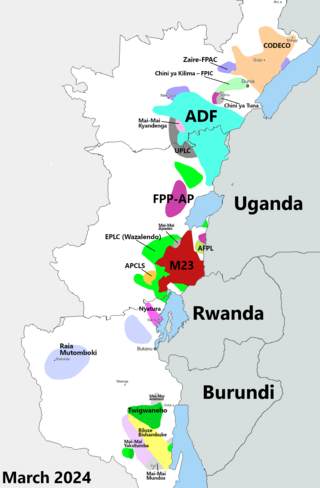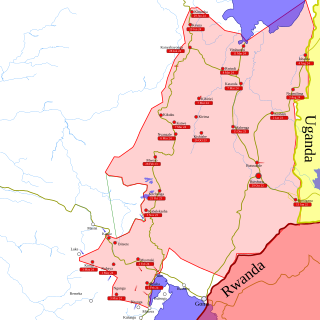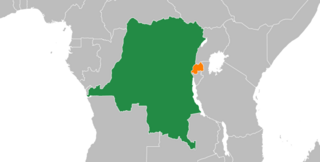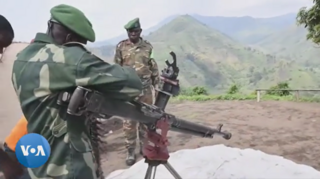
The United Nations Organization Stabilization Mission in the Democratic Republic of the Congo, or MONUSCO, is a United Nations peacekeeping force in the Democratic Republic of the Congo (DRC). A planned withdrawal from the country is currently on indefinite hold due to the unstable security situation.

The East African Community (EAC) is an intergovernmental organisation in East Africa. The EAC's membership consists of eight states: Democratic Republic of the Congo, the Federal Republic of Somalia, the Republics of Burundi, Kenya, Rwanda, South Sudan, Uganda, and Tanzania. William Ruto, the president of Kenya, is the current EAC chairman. The organisation was founded in 1967, collapsed in 1977, and was revived on 7 July 2000. The main objective of the EAC is to foster regional economic integration.
Rutshuru is a town located in the North Kivu province of the eastern Democratic Republic of the Congo, and is headquarters of an administrative district, the Rutshuru Territory. The town lies in the western branch of the Albertine Rift between Lakes Edward and Kivu. The Ugandan border is 15 km east and the Rwandan border is 30 km south-east. Lava flows from the Nyamuragira volcano, 40 km south-west, have come within 7 km of the town in recent years. The town has over 800,000 inhabitants from many tribal backgrounds Nande, hunde and Pygmee.

The Kivu conflict is an umbrella term for a series of protracted armed conflicts in the North Kivu and South Kivu provinces in the eastern Democratic Republic of the Congo which have occurred since the end of the Second Congo War. Including neighboring Ituri province, there are more than 120 different armed groups active in the eastern Democratic Republic of Congo. Currently, some of the most active rebel groups include the Allied Democratic Forces, the Cooperative for the Development of the Congo, the March 23 Movement, and many local Mai Mai militias. In addition to rebel groups and the governmental FARDC troops, a number of national and international organizations have intervened militarily in the conflict, including the United Nations force known as MONUSCO, and an East African Community regional force.
Bosco Ntaganda is a Congolese former rebel leader and convicted war criminal. He was the former military chief of staff of the National Congress for the Defense of the People (CNDP), a rebel that group operated in the North Kivu province of the Democratic Republic of the Congo (DRC) during the first phases of the Kivu conflict. He is also a former member of the Rwandan Patriotic Front (RPF) and a veteran of the Rwandan Civil War, as well as an alleged former Deputy Chief of the General Staff of the Patriotic Forces for the Liberation of Congo (FPLC), the military wing of the Union of Congolese Patriots.

The 2008 Nord-Kivu campaign was an armed conflict in the eastern Nord-Kivu province of the Democratic Republic of the Congo. The upsurge of violence in the Kivu conflict saw heavy battles between the Democratic Republic of Congo's army, supported by the United Nations, and Tutsi militia under General Laurent Nkunda.
The Congolese Rally for Democracy–Goma was a faction of the Congolese Rally for Democracy, a rebel movement based in Goma, Democratic Republic of the Congo (DRC) during the Second Congo War (1998–2003). After the war, some members of the group continued sporadic fighting in North Kivu as Armée Nationale Congolaise (ANC). The movement also entered mainstream politics, participating in democratic elections with little success.

Bunagana is a small town in Rutshuru Territory, North Kivu Province, in eastern Democratic Republic of the Congo, at the border with Uganda. It served as the headquarters of the March 23 Movement (M23) rebel militia in 2013 and has been occupied by M23 since 13 June 2022.

The M23 rebellion was an armed conflict in North Kivu, Democratic Republic of the Congo (DRC), that occurred between the March 23 Movement and government forces between 4 April 2012 and 7 November 2013. It ended when a peace agreement was made among eleven African nations, and the M23 troops surrendered in Uganda. The rebellion was part of continued fighting in the region after the formal end of the Second Congo War in 2003. The conflict reignited in late 2021 after rebel "general" Sultani Makenga and 100 rebel fighters attacked the border town of Bunagana but failed. A few months later, with a much larger force, the rebels of the M23 movement renewed their attack and captured Bunagana.

The March 23 Movement, often abbreviated as M23 and also known as the Congolese Revolutionary Army, is a Congolese Tutsi-led rebel military group. Based in eastern areas of the Democratic Republic of the Congo (DRC), it operates mainly in the province of North Kivu, which borders both Uganda and Rwanda, and is backed by Rwanda. The M23 rebellion of 2012 to 2013 against the DRC government led to the displacement of large numbers of people. On 20 November 2012, M23 took control of Goma, a provincial capital with a population of a million people, but it was requested to evacuate it by the International Conference on the Great Lakes Region because the DRC government had finally agreed to negotiate. In late 2012, Congolese troops, along with UN troops, retook control of Goma, and M23 announced a ceasefire and said that it wanted to resume peace talks.

General Sultani Makenga is a Congolese rebel leader and the military chief of the March 23 Movement (M23), a rebel group based in the eastern Democratic Republic of the Congo.
Bertrand Bisimwa is a Congolese rebel leader who is the president of the March 23 Movement, a rebel group based in eastern areas of the Democratic Republic of the Congo (DRC).

The United Nations Force Intervention Brigade (FIB) is a military formation which constitutes part of the United Nations Organization Stabilization Mission in the Democratic Republic of the Congo (MONUSCO). It was authorized by the United Nations Security Council on 28 March 2013 through Resolution 2098. Although it is not the first instance in which the use of force was authorized by the UN, the Force Intervention Brigade is the first UN peacekeeping operation specifically tasked to carry out targeted offensive operations to "neutralize and disarm" groups considered a threat to state authority and civilian security. In this case, the main target was the M23 militia group, as well as other Congolese and foreign rebel groups. While such operations do not require the support of the Armed Forces of the Democratic Republic of the Congo (FARDC), the Force Intervention Brigade often acts in unison with the FARDC to disarm rebel groups.

In late March 2022, the March 23 Movement (M23), supported by Rwanda, launched an offensive in North Kivu against the Armed Forces of the Democratic Republic of the Congo (FARDC), and MONUSCO. The fighting displaced hundreds of thousands of civilians and caused renewed tensions between the Democratic Republic of the Congo and Rwanda.

A conflict began between the Democratic Republic of the Congo (DRC) and Rwanda in 2022 after Rwandan forces entered the country to provide military support to the March 23 Movement (M23) rebel group, including fighting alongside them against the Congolese military (FARDC) and pro-government militias.
Events of the year 2024 in the Democratic Republic of the Congo.

The Second battle of Kitshanga broke out between Rwandan-backed M23 fighters and self-defense groups known as Wazalendo allied with the Congolese government. In January 2023, M23 rebels captured Kitshanga from the Congolese Army and allied forces in their renewed offensive in North Kivu. Wazalendo forces captured Kitshanga in early October 2023 as part of a counteroffensive, with the city switching hands between Wazalendo and the M23 after October 16, and a second M23 offensive on October 21 capturing the town.
Events of the year 2025 in the Democratic Republic of the Congo.

The Goma offensive was a military operation launched by the March 23 Movement (M23), a Congolese rebel group that is part of the Congo River Alliance (AFC) and is supported by Rwanda, against the regional capital of Goma in the Democratic Republic of the Congo (DRC). It lasted from January 23 to January 30, 2025. The campaign was part of the larger M23 campaign in the North and South Kivu provinces of the DRC, which resumed in October 2024 after a pause. During January 2025 the M23 rebels made a rapid advance in the Kivu region, cutting off the road connections to the North Kivu provincial capital Goma by January 23 and arriving at the city on January 25.
The 2025 Kinshasa riots are a series of violent demonstrations that occurred on January 28, 2025 in Kinshasa, the capital of the Democratic Republic of the Congo (DRC). Multiple foreign diplomatic missions, including the embassies of the United States, France, Netherlands, Belgium, Rwanda, Kenya, and Uganda, became targets of civil unrest as protesters expressed their opposition to perceived international inaction regarding M23 rebel advances in eastern DRC and Goma.












